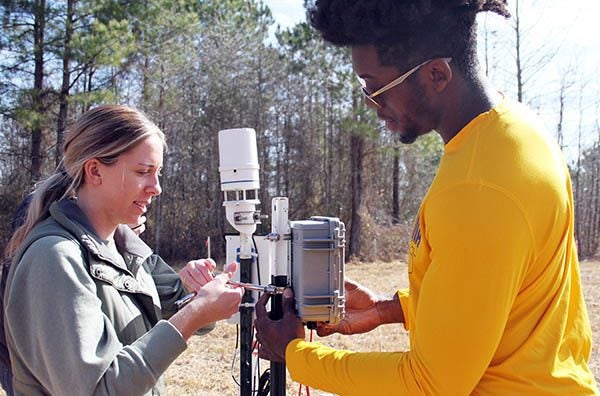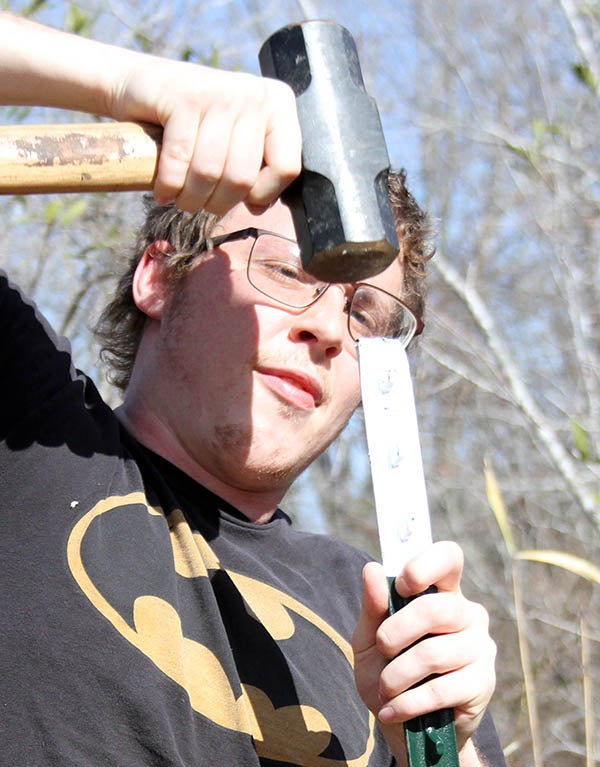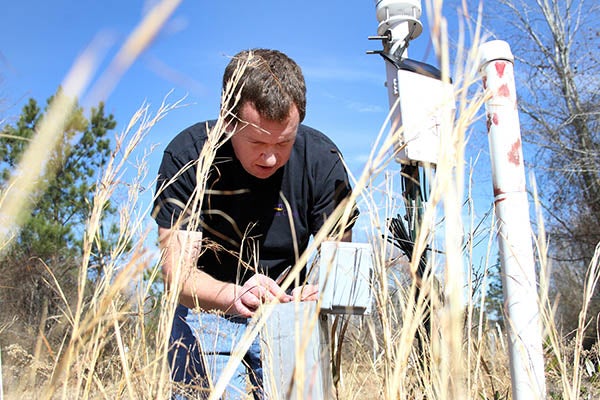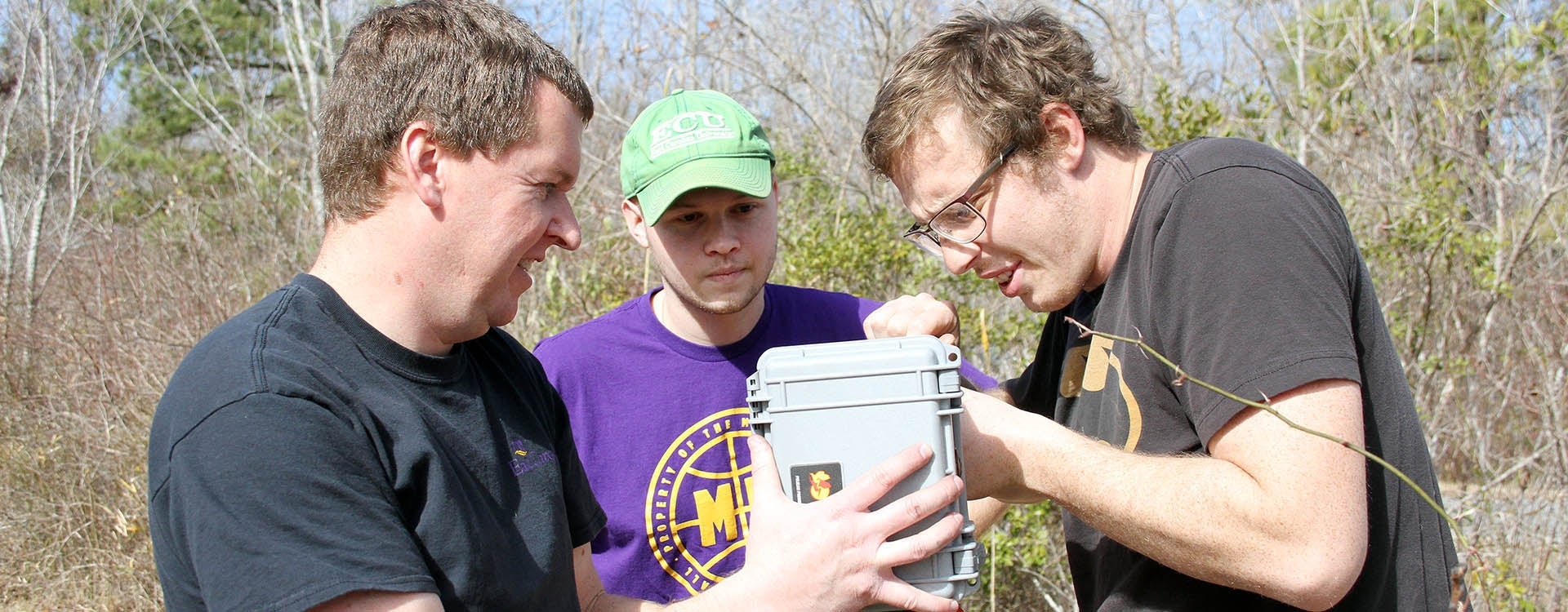ALWAYS LEARNING
ECU engineering students install equipment to support environmental research
Engineers are always learning — even if that learning takes place on a warm afternoon in the middle of a field.

ECU students Julie Miller and Samson Strickland install equipment to collect data from groundwater wells on the West Research Campus.
A group of engineering students at East Carolina University recently installed water sensors to support environmental research on the West Research Campus. The departments of biology, geology and engineering, the ECU Water Resources Center and the Center for Sustainable Energy and Environmental Engineering (CSE3) teamed up for the work.
The sensors will provide real-time data on water levels and temperatures in groundwater wells as researchers explore the effects of fertilization, mowing and drainage ditches on the plant community.
“If you’re an engineer, you know how to learn. It doesn’t matter what it is,” said Julie Miller, a senior environmental engineering student and CSE3 student researcher from Toms River, New Jersey.
On this day, students slogged through mud, fought off fire ants and endured warm temperatures to pound stakes in the ground, mount data boxes and drop sensors down wells.
“I enjoy getting outside and doing hands-on work instead of just working on a computer,” Miller said. “I like seeing plans put into action, designing something and actually seeing it.”
Zeke Holloman, a senior electrical engineering major and CSE3 student researcher from Greenville, configured the Mayfly microcontrollers used to collect the data and worked on getting the data sent to the internet. Before the sensors were installed, students had to physically go to the site and download the data from loggers.
“I really enjoyed this,” Holloman said. “It’s been awhile coming, but it’s been super awesome to see it all come together and see everything get deployed. It’s great.”
Holloman is set to graduate in May and then plans to pursue a Master of Business Administration with hopes of pursuing a career as a project manager in an engineering company.
“I love learning. It’s super great. It’s one of my favorite things,” he said.

ECU research technician Brian Hinckley pounds a stake into the ground as part of the installation of new sensors on the West Research Campus.
For now, he’s just happy a project on which he worked could help the environment.
“Knowing in the future this could help people and inform decisions later down the road with the technology and having this available, it’s just really nice,” he said.
Samson Strickland, a senior environmental health major from Wilson, works with ECU’s Water Resources Center. As part of the Coastlines and People Project team, he collects water samples and tests for such things as pH levels, ammonia, phosphate and nitrate.
“It basically gives folks peace of mind or can alert them to issues that may be going on with their water quality,” he said.
His role on this day was a little more limited.
“I’m just out here as an extra hand to help, but I love this stuff,” he said. “You learn a lot and you’re able to make sure that the environment is pretty healthy, so I really enjoy it.”
He said he’s worked on a variety of projects, from COVID-19 wastewater testing to pool sanitation. Later this semester, he’ll be working on mosquito research.
“I’m lucky to get so much experience,” he said. “There are so many things the environmental health field offers. Just like engineering, it’s hard to pinpoint one thing. So, I’ve got a very broad interest when it comes to this stuff.”
Dr. Carol Goodwillie, associate professor in the Department of Biology, works with fellow associate professor in biology Dr. Ariane Peralta on the research.
“Our results are helping us to understand the potential effects of human-caused nutrient enrichment of the environment, such as fertilizer runoff and deposition of airborne nutrients from industrial processes,” Goodwillie said. “Our results also shed light on how suppression of wildfires — a natural, historically important form of disturbance in our region — affects the diversity of plant communities. Finally, we’re interested in how drainage ditches — an ever-present feature of the human impacted landscape in the coastal plain — affect the plants that grow in natural areas.”
The research has been going on since 2003.
“Fertilization, lack of mowing and close proximity to the ditch or drainage have similar effects in reducing the diversity of the plant community,” Goodwillie said. “With both fertilization and drainage, we tend to lose slow-growing, wetland specialist species. Without mowing, the plant community has shifted to one dominated by a few rapidly growing trees and vines, and we have lost small plants of the understory.”

Dr. Randall Etheridge installs new equipment at the West Research Campus.
Goodwillie worked with Dr. Randall Etheridge, associate professor with the Department of Engineering and CSE3, to have the new sensors installed and relishes the opportunity for research collaboration.
“It’s exciting to see the layers of investigation being added to the original research on the plant community,” she said. “There’s great potential to learn more and also train our students in interdisciplinary science. The links between our groups are both research and education oriented, as the experiment is the focus of several CUREs (Course-Based Research Experiences) for undergrads.”
She said the research provides undergraduate students the opportunity to participate in an authentic large-scale ecological study.
“I hope that my next group of students in the vegetation sampling CURE will be able to use data made possible by the new equipment as they formulate and test hypotheses about ecological processes going on in the research plots,” Goodwillie said.
Etheridge said the work by the CSE3 students is the first step in a pilot project involving the Water Resources Center, Dr. Ciprian Popoviciu, assistant professor in the Department of Technology Systems, and ECU’s Information Technology and Computer Services.
“We are slowly implementing the hardware to allow us to collect data in real time on campus,” Etheridge said. “This is not a new idea, but we are attempting to do it using low-cost, do-it-yourself equipment. The initial focus is on water resources, but we plan to expand beyond that. The equipment we installed is our pilot using cellular data transmission. We are discussing the first deployment on main campus using a different and cheaper radio technology.”
